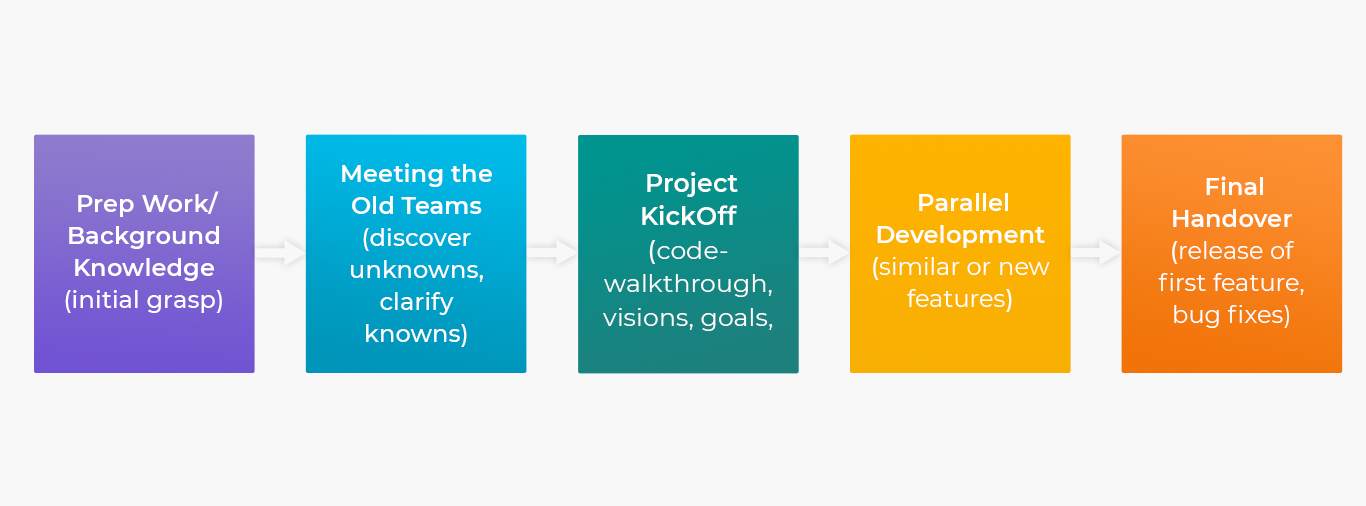Every once-in-a-while companies have face-time with someone others code. These are the inherited codebases that are no longer considered optimal for the organizations, termed as the legacy codes.
The most crucial inventory to keep, dealing with such old codebases is quite a challenge for the teams. And if not handled properly, these codebases bring many hidden risks along with them.
This article covers the ins-and-outs of the legacy codebases and the better ways to handle these with the utmost ease.
Let’s begin by defining the Legacy code first.

What is a Legacy Code?
The classic definition of legacy code is, the code maintained by someone who didn’t write it. This inculcates that the code works even though nobody really knows why.
As the application development process modernized, the definition for legacy code also got refurbished because of its associated challenges.
The formal and the latest definition of legacy code defines it as an ‘alien’ code which is difficult to understand with respect to the current development scenario and is difficult to change. Such codes are inherited from an old team, other development agencies, programmers or from the older software versions.
Spaghetti Codes, Technical Codebase Debts are the other names that have been given to the legacy codes.
Challenges Accompanying Legacy Codes
Legacy code is old, it worked, but what is that which makes it incapable? What is so bad about it? Read ahead.
#1 In Loop Confusions: Once the legacy code made sense, it worked the way it had to. But the older it gets, it becomes muddled and brings a lot of confusion for the teams maintaining it.
Eventually, the scenario builds like nobody knows how to do the maintenance or revamp such codebases. Nobody wants to mess with such codebase as it comes with so many dependencies. Also, the developers might not know where to start in tackling such codebase issues as there is a fear of breaking something fundamental in the code structure if they try.
#2 Stability Illusions: At the time of its writing, the legacy code was tried and tested, making it safe for the working environment. But with the evolution of coding languages, practices, and understandings, the legacy code loses its stability. Any new feature update makes it more tangled, thus, negatively impacting the quality of the code.

#3 Refactoring is Daunting: When a code is old or obsolete, it is very difficult to match it with the latest coding standards. The risks and costs of updating codes are quite high. If in any case a problem or issue arises, it becomes harder to fix them cost-effectively and rapidly. This implies that legacy code is capable of holding a business back with its incapability of integration with new technologies.
#4 Money and Resource Exploitation: A legacy code is a kind of inventory and as the inventory is obsolete, it needs to be updated on a regular basis. Also, being an older codebase, a legacy code requires older hardware and systems to run. This accelerates the cost as the obsolete systems or hardware is expensive to integrate and maintain.
#5 Prominent Cyberattacks: The ever-evolving security threats are the next set of dangers for the legacy codes. Cyber attackers are loaded with the knowledge of the weaknesses in older systems which is enough to cripple the fully functional system. If the system is not in-line with the current coding standards, it makes it an easy target for cyber-criminals.
If the code is your inventory then you need to update it when needed, delete it when not required, so as to keep up with the current development scenario.
The next few sections will describe the considerations and approaches for addressing the legacy codes.
Considerations before approaching a Legacy Code
Planning to revamp the legacy code?
The following things need to be considered before making any further changes in it.
- Age of the Code: Technologies, languages, and frameworks tend to update and improve as time goes on. When talking about the legacy codes, the emergence of new and better language alternatives lets the replacement of old with the new. This makes difficult to find developers who are willing and capable to maintain the code in its original language. Knowledge of the age of the codebase will help in decoding the fundamentals or get an idea about the initial days of the code.
- Number of Iterations: Change is the only constant when it comes to matching consistent business goals and functionality requirements. Numerous iterations pile up when updates or any changes in the codes are done. With each system upgrade, developers’ are unwilling to remove the old functions. This makes the code complicated to handle with many duplicated functionalities and unwanted areas.
- Resource Consumption: The background research of the age and the codebase changes provides a firm base for the calculation of the resources for a project, for example, the addition of any functionality or value, cost reduction, performance improvements, etc.
Steps to Successfully Handle Legacy Codebase Inheritance
The existing codebases come with a lot of incoherence and uncertainties. Since such projects come with tight deadlines, there is a limited time to get a full grasp of the project. That is why it is suggested to follow a tested approach for the same. The below points describe the step by step procedure to follow for handling a legacy codebase:

Prep Work / Background Knowledge
Before starting with legacy code, it is always recommended to get an overview of the code. Keep a note and understand the workflow, naming conventions, call hierarchies, patterns, code structure, backend, etc. This will give a basic idea of what the code is doing.
Along with this, read the basic project documentation, README files to get an idea of the application functions and tests required.
Create flowcharts, diagrams, sketches, etc. that will help in identifying the uniques areas, features of the project which will create the context more clear, eventually leading to a seamless project handling experience.
Following are the gains from this step:
- A clear understanding of the project entry points and data flow.
- Full system overview which includes the internal and external dependencies and teams handling these.
- Clear database structure knowledge.
- Understanding of the deployment process and the level of automation in the project.
Meeting the Old Teams
For the purpose of doing a reality check of what has been understood so far, it is imperative to meet and spend time with the earlier associated coding experts. Uncover the knowns and unknowns with the list of questions and documentation created by the initial understanding. Following things can be covered in the meeting:
- Project domain overview
- Configuration of the development environment
- End-user side of the application
- How to test and deploy the project
- Updates on the README
Following are the outcomes from the meeting of old and new teams :
- A more clear understanding of the working of the project.
- More detailed documentation of the project.
- Understanding of the delicate and trickier parts of the system.
- List and details of the technical dues, like the issues, their emergence, and the approach for resolving them.
- The decision history, stating, how and why of a particular development decision. This will provide an edge to the new teams to handle the upcoming challenges in a more informed way.
- The list of application constraints so as to keep a check on what to follow or what to not.
Project Kickoff
After gathering enough information about the project, it is recommended to bring the teams onboard through a small event or meeting. The participants here will be the product owners, developers from the new team, and other important roles responsible for the development of an application.
Such gatherings offer:
- Demonstration of the features of the current project.
- Code walk-through with the existing dependencies in the system.
- Vision and goals of the new application.
- Product and technology-related concerns.
- Details on the teams' formation and responsibilities.
- Key performance indicators (KPIs) to measure the success of the project.
- Lists of the upcoming backlogs.
Parallel Development
After the successful initial on-boarding session, features can be added to the project. Before moving ahead with the new feature addition, it is suggested to know how similar features have been implemented and how it actually works.
Both the old and the new teams work in parallel for the implementation of the new or similar features on the project. Recommendations are to keep the development practices and processes of the existing team in-place so as to limit unnecessary friction between the old and the new teams. This will lead to a smooth and stable transition of the project development process.
When it comes to testing, a background check of the test setup should be done to get an idea of the testing process of a similar feature. Further, followed by project release and deployment. This phase assures that the new team is doing at least one production deployment and is also resolving the upcoming issues.
Later, a second meeting with the old team is done to review the project progress, queries related to the project, technical debts and keeping a check whether everyone from the new team is on the same page of the development process.
Final Handover
Once the new team gets most of the understanding of the codebase and is consistently adding features on the application. Now the inherited codebase can be updated in accordance with the existing environment.
Issues on the features are addressed by the newly assigned team, taking complete control over the project. Thus, the team will now do the complete maintenance of the system and keep a check on the following :
- Are there any issues with the existing code?
- Is it the time for the dependency update?
- Are the patterns still working after the project's up-gradation?
It is recommended to handle the inherited code as the ‘own’ original written code. Make changes when needed, delete the unwanted pieces. All in all this phase keeps the record of the complete health of the system and makes sure that it is shipshape.
Conclusion
Inheriting legacy codebase comes under the ancient ways of the development process. But as it addresses many functional requirements, it is still being widely used. Dealing with legacy code is a challenge. A well-planned approach and technique need to be followed so as to make the process of inheritance and handover easier.
What do you think of Legacy Code Inheritance? Share your views on our social media channels: Facebook, LinkedIn, and Twitter.
Feel free to drop a line at [email protected] if you’ve learned some other things about maintaining the legacy code.
Subscribe
Related Blogs
In conversation with Danish Usmani, CEO, OpenSense Labs

In a year-end interview, CEO Danish Usmani showcases OpenSense Labs' achievements, emphasising new client partnerships and expansions. He…
Why should you prioritize lean digital in your company?

We are living in an era where the change and innovation rate is just so high. If you want your organization to reach new heights then you…
How to measure your open source program’s success?

Along with active participation, it is very important to look after the ROI of open-source projects, programs, and contributions. The…



